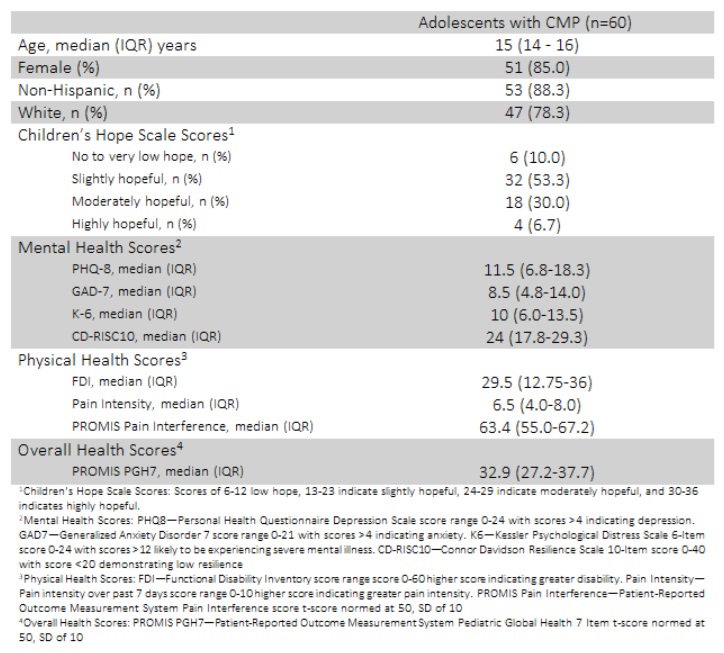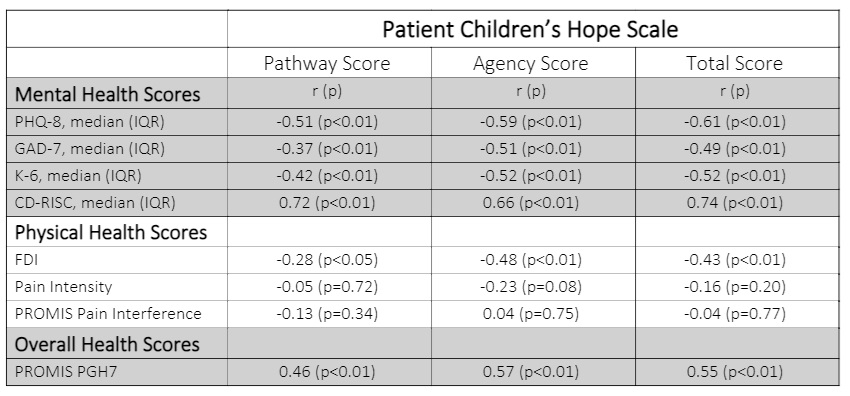Session Information
Session Type: Poster Session C
Session Time: 10:30AM-12:30PM
Background/Purpose: Hope, the capability to derive pathways to desired goals and motivate oneself via agency thinking plays a protective role in pediatric health contributing to improved quality of life, coping, and positive health changes. Prior studies suggest that youth with chronic illnesses report lower hope and youth with chronic musculoskeletal pain report (CMP) lower health related quality of life. Yet, the relationship between hope and patient reported health outcomes (PROs) in youth with CMP remains unknown. We aimed to quantify hope levels in adolescents with CMP; examine the relationship between patient and caregiver hope; and examine demographics, clinical characteristics, and patient reported outcomes associated with hope.
Methods: We conducted a secondary analysis of baseline data from a prospective longitudinal survey of youth-caregiver dyads presenting to a pediatric subspeciality pain clinic. Eligibility criteria included: ages 12-17 years, diagnosis of CMP defined as bone, joint, muscle, or related soft tissue pain lasting ≥ 3 months by the treating physician, English proficiency, presenting to Amplified Musculoskeletal Pain Syndrome clinic. Eligible dyads completed multiple surveys of greatest importance to this analysis including: 1) hope scores 2) PROs mental health scores 3) PROs physical health scores, 4) PROs overall health scores. Spearman’s rank correlation coefficients were used to evaluate associations.
Results: 60 patient-caregiver dyads completed their assessments and were included in this cross-sectional analysis. Baseline characteristics of the adolescent CMP cohort are summarized in Table 1. In terms of mental health measures, we observed a moderate negative correlation between hope scores and depression (r=-0.61, p< 0.01), anxiety (r=-0.49, p< 0.01), and psychological distress (r=-0.52, p< 0.01), and strong positive correlation between hope scores and resilience (r=0.74, p< 0.01). Furthermore, hope scores did not correlate with pain intensity or pain interference however had a moderate negative correlation with the level of disability patients experienced (r=-0.43, p< 0.01). A moderate positive correlation was found between patient reported hope scores and overall health (r=0.55, p< 0.01) (Table 2). Weak positive correlation was found between patient and caregiver hope pathway subscore (r=0.27, p< 0.05) whereas dyad hope agency subscore and total hope scores did not correlate (Table 3).
Conclusion: Youth with CMP were on average slightly hopeful (mean 20.7, SD 0.82) and had lower levels of hope than that of similar age youth in the general population. Additionally, hope had significant correlation with mental health measures, functional disability, and overall health in youth with CMP. Of note, the agency sub-score demonstrated a stronger correlation in many of the PROs. Interestingly, there was minimal correlation between patient and caregiver hope scores suggesting that hope was not built on the shared environment but rather on more independent internal factors. Further investigation remains necessary to better elucidate which interventions are most likely to bolster hope in youth with CMP to improve their mental health, functional disability, and overall health.
To cite this abstract in AMA style:
Chern I, McGill M, Butler N, Gmuca S. Hope and Health in Adolescents with Chronic Musculoskeletal Pain [abstract]. Arthritis Rheumatol. 2024; 76 (suppl 9). https://acrabstracts.org/abstract/hope-and-health-in-adolescents-with-chronic-musculoskeletal-pain/. Accessed .« Back to ACR Convergence 2024
ACR Meeting Abstracts - https://acrabstracts.org/abstract/hope-and-health-in-adolescents-with-chronic-musculoskeletal-pain/



